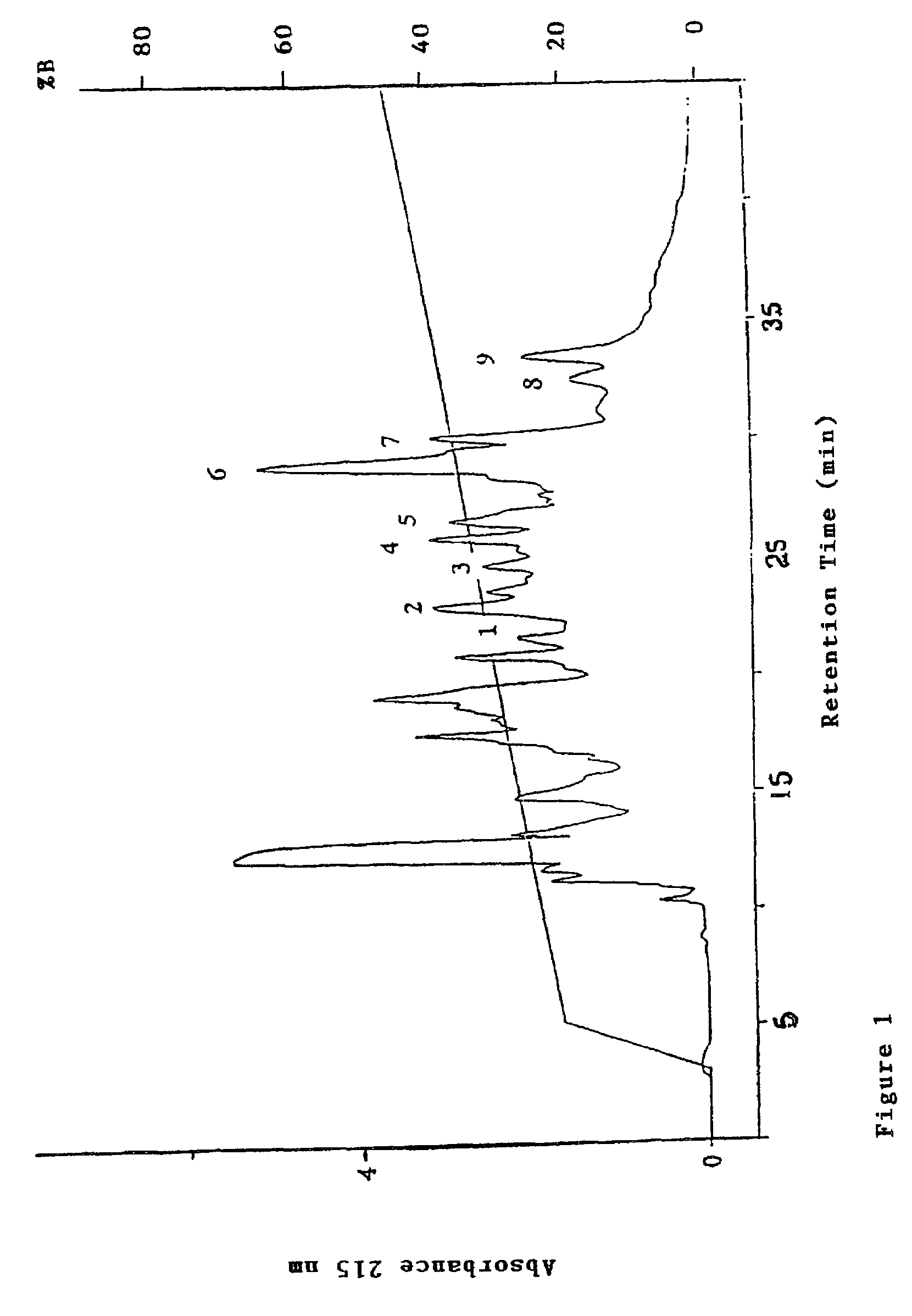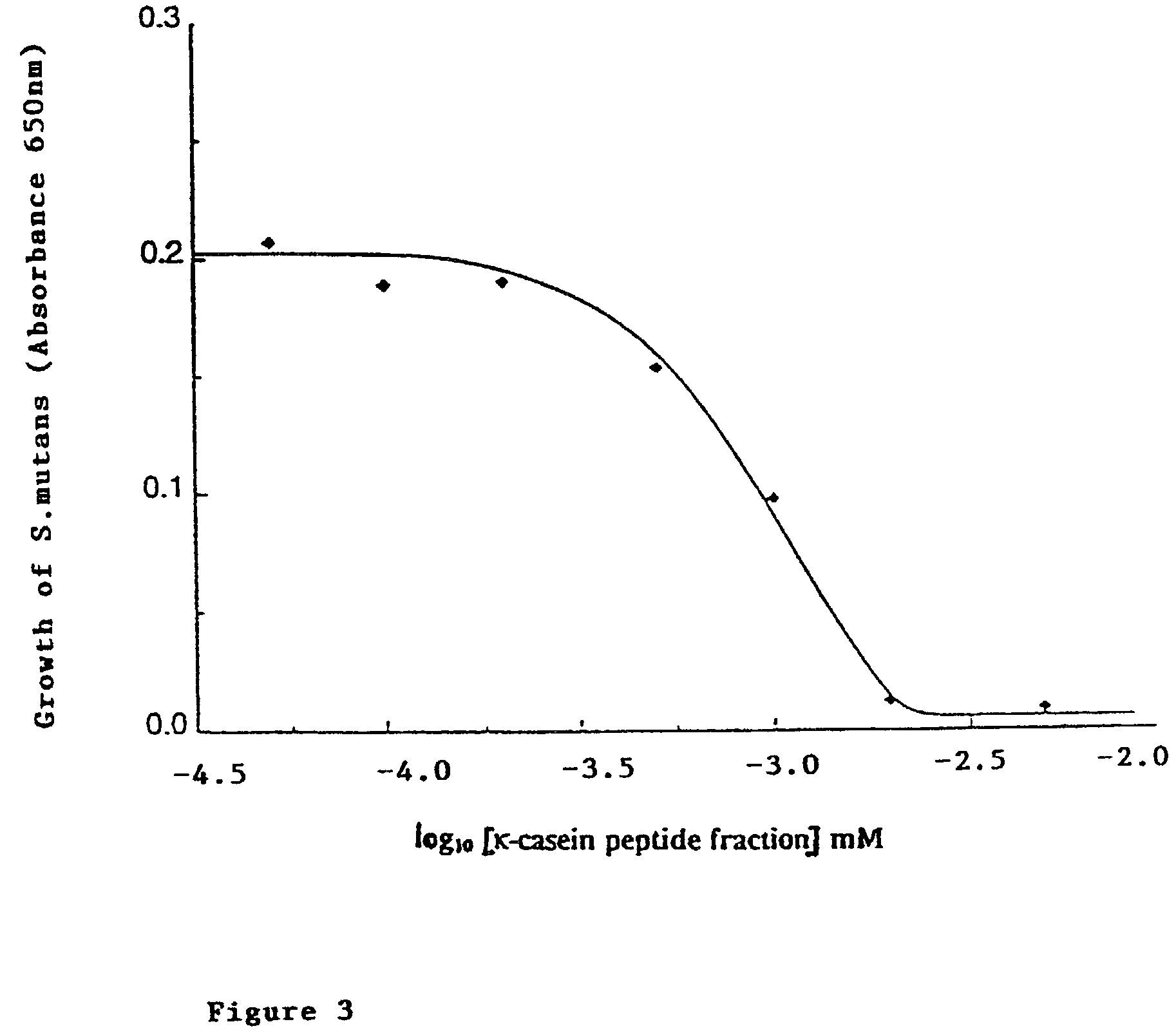Antimicrobial peptides
- Summary
- Abstract
- Description
- Claims
- Application Information
AI Technical Summary
Benefits of technology
Problems solved by technology
Method used
Image
Examples
example 1
Preparation of Antimicrobial Peptides from a Tryptic Digest of Whey Protein Concentrate
[0124]Whey protein concentrate (50 mg / ml) in water (pH 8.0) was hydrolysed using Novo trypsin (1 mg / ml) at 50° C. for 2 h with the pH maintained at 8.00±0.01 by the addition of 1N NaOH. Hydrolysis was terminated by the addition of 1M HCl to pH 4.6. The hydrolysate was centrifuged (11,600 g for 10 min) and then filtered through a 0.2 μm PVDF filter before being applied to a 7 μm C8 (Brownlee) reversed-phase column (4.6×220 mm). The sample was eluted using an Applied Biosystems 140 A Solvent Delivery System to generate a stepwise linear gradient from 0-20% B in 2 min followed by 20-45% B in 40 min at a flow rate of 1 ml / min. Eluant A was 0.1% (v / v) TFA in water and eluant B was 80% (v / v) acetronitrile, 0.1% (v / v) TFA in water. The eluant was monitored using an Applied Biosystems 1000S Diode Array detector at a primary wavelength of 215 nm. The chromatogram obtained is shown in FIG. 1. Peaks were col...
example 2
A. Preparation of Antimicrobial Peptides from Cheese Whey
[0126]Cheese whey was ultrafiltered (UF) though a 20,000 molecular weight cut off membrane. The filtrate was collected and proteins were precipitated by addition of trichloroacetic acid (TCA) to a final concentration of 11% w / v. Precipitated proteins were removed by centrifugation (10,000 g, 5 min) and the neutralised supernatant was lyophilised. The dried TCA-soluble UF whey was dissolved in 0.1% TFA in water and subjected to RP-HPLC. The sample was applied to a Brownlee aquapore analytical (C18) reversed-phase column (220×4.6 mm) or a Brownlee (C18) preparative column (25 cm×10 mm). Solvent B consisted of 90% acetonitrile containing 0.1% v / v TFA and solvent A consisted of 0.1% TFA in water. The eluant was monitored using an Applied Biosystems Incorporated (ABI; Melbourne, Vic., Australia) 1000S diode array detector at a wavelength of 215 nm.
[0127]The sample was applied to the Brownlee analytical column and eluted using a gra...
example 3
[0157]Sodium caseinate was dissolved in 150 mM NH4HCO3 pH 8.0 at 10% (w / v) and hydrolysed using Novo trypsin (2 g / L) at 50° C. for 2 h. Hydrolysis was terminated by the addition of 1N HCl to pH 4.6 and the undigested protein removed by centrifugation. A sample of the hydrolysate was applied to a 7 μm Applied Biosystems C8 column (4.6×220 mm) and eluted (as described in Example 1. Peaks were collected and assayed for antimicrobial activity against Streptococcus sanguinis. Two peptides showed activity, Ser(P)149 κ-casein (117-169) ((SEQ ID NO:12) and (SEQ ID NO:14)) and β-casein (184-202) (SEQ ID NO:7).
B. Rennet Hydrolysis
[0158]Casein HCl (5 g) was dissolved in 100 ml of 100 mM ammonium bicarbonate pH 8.0. Once the casein had dissolved the pH was lowered to 6.3 with 1 M HCl and 1 mg of rennet (chymosin, Sigma) was added and the mixture incubated for 1 h at 37° C. TCA (11% w / v) was added to the solution or the pH was lowered to 4.5 by the addition of 1 M HCl and th...
PUM
| Property | Measurement | Unit |
|---|---|---|
| Fraction | aaaaa | aaaaa |
| Fraction | aaaaa | aaaaa |
| Fraction | aaaaa | aaaaa |
Abstract
Description
Claims
Application Information
 Login to View More
Login to View More - R&D
- Intellectual Property
- Life Sciences
- Materials
- Tech Scout
- Unparalleled Data Quality
- Higher Quality Content
- 60% Fewer Hallucinations
Browse by: Latest US Patents, China's latest patents, Technical Efficacy Thesaurus, Application Domain, Technology Topic, Popular Technical Reports.
© 2025 PatSnap. All rights reserved.Legal|Privacy policy|Modern Slavery Act Transparency Statement|Sitemap|About US| Contact US: help@patsnap.com



